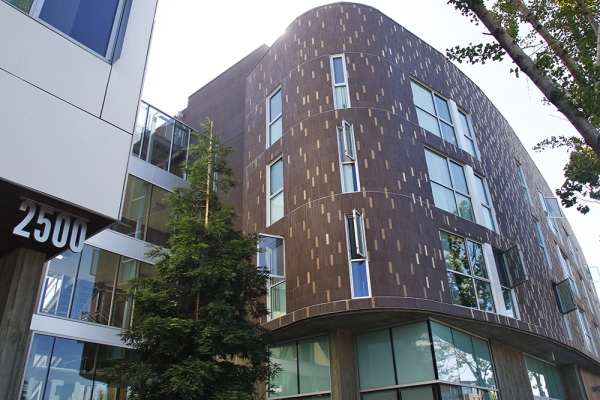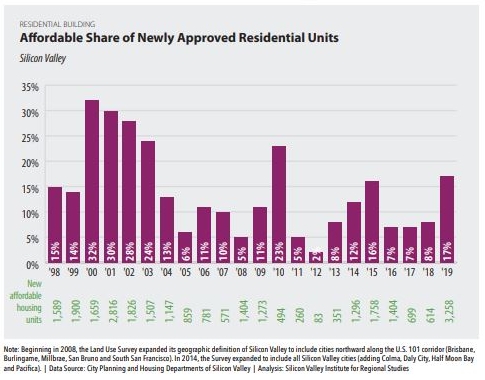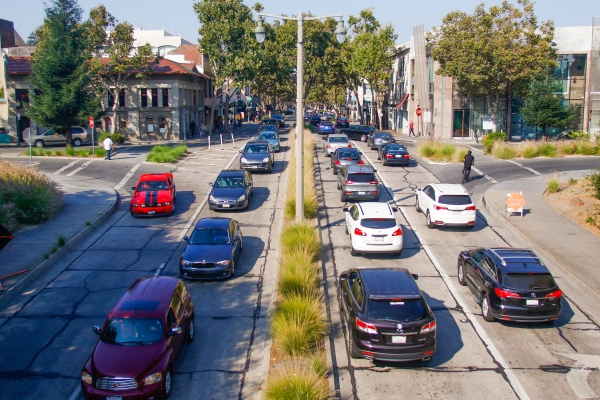Despite a hot economy and a slight dip in home prices, 2019 was a year of reckoning for Silicon Valley's high-tech giants, with a growing number of residents and city leaders demanding greater contributions to combat the area's deep housing shortage, according to a new report from Joint Venture Silicon Valley.
The Silicon Valley Index, an annual overview of the region's economic and demographical trends, highlights some of the region's most notable trends of 2019, including the continued expansion of commercial development and a slight decline in home sale prices after seven years of rapid gains. While the report celebrates the region's "upward spiral," as evidenced by a $17 billion increase in the regional gross domestic product, a slate of new hotels popping up around the region and 30,000 new jobs, it also details the dark side of the surging economy, including traffic gridlock and housing prices that continue to drive people away.
"Against a flourishing economic backdrop, conditions are harsh for the broad peripheries of the population as inequality reaches new dimensions and wage gains are lost to the rising costs of living," the report's introduction states. "Despite recent progress, the region still has the nation's highest housing prices and our transportation challenges continue to mount."
Russell Hancock, president and CEO of Joint Venture Silicon Valley, reflected on this dichotomy in his introductory letter for the report, which noted that the Bay Area has added 821,000 jobs since the recession of 2008. This, he noted, is the equivalent of dropping another city the size of San Francisco into the region.
While he celebrated the area's engineering savvy, strong universities and deep pools of capital, Hancock also asked: "So why does it feel so tenuous?"
The answer, he says, is insufficient housing stock. The region has only added about 173,000 housing units since 2008, a jobs-housing mismatch of nearly 5 to 1.
"The result is the nation's highest housing prices, an unsettled workforce and a transportation system sagging under the weight of 100,000 megacommuters," Hancock wrote. "Add to this the nation's most sharply pronounced income gaps and you have a formula for despair."
It doesn't help, he added, that the region's driving industries are "facing a backlash the likes of which we've never seen."
"As technology plays a deeper and more pervasive role in nearly every aspect of our lives, that role has come under question and the region feels like it's under siege," Hancock wrote.
Despite the recent years of prosperity, income inequality in Silicon Valley is now at a "historic high," according to the report, with 13% of the households holding more than 75% of the region's wealth. Furthermore, while 13% of the region's households have more than $1 million in net assets, 37% have less than $25,000 in savings.
Even though Silicon Valley and San Francisco remain the two most expensive metro regions in the nation when it comes to housing costs, Silicon Valley's median home sale prices actually declined by 6%, or about $75,000, in 2019. The report posits that this may reflect "a cooling overall market" and possibly a shift of activity away from higher-end homes.
Despite widespread recognition of the region's housing shortage and efforts by state and local legislators to address the housing affordability crisis, building permit activity for residential construction actually slowed in 2019, according to the Index. Most of the permits were issued to homes that are only affordable to high-income individuals.
Apartment rents, meanwhile, remain sky-high compared to the rest of the nation. According to the Index, the median apartment rental rate per square foot in 2019 was $3.76 in San Francisco and $3.32 in San Jose. This is well above the median of $2.67 in California and roughly double the rate of $1.73 in the United States.
The report notes that 23% of Silicon Valley households who rented were "severely burdened" by housing costs, which means they had spent more than 50% of their gross income on housing.
Yet the report also notes that there is a relatively large amount of affordable housing in the region's development pipeline. There were 3,258 "affordable housing" units (those deemed affordable for residents earning up to 80% of the area median income) approved in fiscal year 2018-2019 — more than in any other year of the past two decades. By contrast, there were just 699 units of affordable housing approved in 2017 and 614 in 2018.
And while the affordable housing units made up just 17% of the total number of newly approved units, that is the highest percentage since 2010, when 23% of the new units were deemed affordable (in 2017 and 2018, the share was 7% and 8%, respectively).
The report points out that the shares of multigenerational and multifamily households remain high and that more than a third of all young adults live with a parent.
"Homelessness and housing insecurity remain critical issues," the report states. "Further compounding the issue is the reality that many of Silicon Valley's residential units are vacant, underutilized, inadequate or otherwise deficient."
While residential development is rolling out slowly, commercial growth boomed in 2019, with 8.5 million square feet of commercial space completed in Silicon Valley in 2019 — an 18-year high. And more commercial construction is on the way, with LinkedIn, Google, Microsoft, Adobe and Nvidia all moving forward with constructing office space as 2019 came to an end.
"Although asking rents in Silicon Valley are relatively high compared to other growing tech regions across the nation, the region's major tech companies have continued to expand their presence with an increasing real estate footprint," the Index states.
The link between growing tech campuses and the region's housing and transportation problems has become a major theme for local governments throughout the region. Several cities, including Mountain View and East Palo Alto, have recently instituted business taxes to help address these issues. Palo Alto is preparing to place a business tax on its November ballot, with revenues targeting transportation improvements.
Several candidates for Senate District 13, which includes large portions of San Mateo and Santa Clara counties, also have called for policies that would require tech companies to do more to address the region's housing crisis. Josh Becker has proposed requiring tech firms to build a housing unit for every job they create, while Michael Brownrigg suggested creating a "credit" market for new housing, with residential builders selling credits for new units to commercial developers.
The Index also highlighted the changes in Silicon Valley's population, which is becoming increasingly diverse. Growth has slowed, with more residents migrating out of the region than coming in for the third straight year. According to the Index, Santa Clara County ranked fourth among California's 58 counties for net domestic out-migration between July 2018 and July 2019, trailing only Los Angeles, Butte and Orange counties.
Silicon Valley's share of foreign-born residents has continued to slowly rise, reaching 38% in 2018, according to the Index. This is fueled by employed residents and those working in technical occupations. According to the Index, more of the region's tech talent in 2018 was from India and China than from California and the rest of the United States combined.
The region's housing shortage also has compounded its traffic problems. Despite efforts by municipalities to discourage driving, the Index notes that the average number of miles driven by Silicon Valley commuters has remained steady over the past three years at about 22 miles per day. Solo commuting remains the most common way to get to work, with 73% of employees driving alone, and public transit use per capita has been on the decline since 2015 on almost all systems (Caltrain's ridership declined in 2019 for the first time since 2010).
According to the report, 6.6% of Silicon Valley employees (more than 101,000 people) had spent more than three hours commuting to and from work on a daily basis. "The number of vehicle hours wasted due to traffic congestion: in Silicon Valley and the Bay Area has tripled between 2009 and 2019," the report states.
"Increases in the number of commuters and the utilization of certain commute paths have led to an unprecedented level of traffic delays in Silicon Valley, with 81,000 hours lost to congestion every day — amounting to an estimated loss in regional productivity of as much as $3.4 billion annually," the report states.
View multiple charts illustrating the report's findings here.





Comments
Slater
on Feb 12, 2020 at 6:27 pm
on Feb 12, 2020 at 6:27 pm
Corporate executives dominate state and local politics. They don't care about inequality. They want more housing for their current and planned workers. They want El Camino Real transformed for their benefit - traffic consequences be darned. It is called the GRAND BOULEVARD INTIATIVE. Ask Russell Hancock about it. It is all about da money.
Old Mountain View
on Feb 13, 2020 at 12:48 pm
on Feb 13, 2020 at 12:48 pm
If I make $50k and you make $60k, your're doing better than I am, and there's an income inequality of $10k.
If we both double our incomes through increased demand for our skills, improving our skills, etc. I make $100k and you make $120k.
We're both doing better than we were before. But now the income inequality doubled from $10k to $20k.
Is an increase in income inequality always indicative of some kind of increase in unfairness?
Jackson Park
on Feb 13, 2020 at 2:50 pm
on Feb 13, 2020 at 2:50 pm
The local and state regulations inhibit development. That is all.
Monta Loma
on Feb 13, 2020 at 5:37 pm
on Feb 13, 2020 at 5:37 pm
"Is an increase in income inequality always indicative of some kind of increase in unfairness?"
Ummm, did you read the attached article?
....with 13% of the households holding more than 75% of the region's wealth.
Monta Loma
on Feb 14, 2020 at 8:36 pm
on Feb 14, 2020 at 8:36 pm
Dear All, I strongly suggest a read of Don Watkins and Yaron Brook's excellent book Equal is Unfair. Rising income inequality is a common narrative from the left but the same people who raise the minimum wage hurt the ones they claim to help. Look at the local MTV Walmart after min wage rise. More do it yourself scanners and less cashiers. Forced equality will not achieve success.
Castro City
on Feb 14, 2020 at 9:20 pm
on Feb 14, 2020 at 9:20 pm
In response to Resident who said:
“If I make $50k and you make $60k, your're doing better than I am, and there's an income inequality of $10k.”
That is exactly correct where the work being done is similar, your productivity is similar, and that there is a stable need for your services. You said:
“If we both double our incomes through increased demand for our skills, improving our skills, etc. I make $100k and you make $120k.”
If all things are identical from above, there is a disparity occurring. There has always been either intentional pay discrimination or unintentional, either are to be prevented. I have a Business Degree in Human Resources, and there is very little effort done to address these problems.
The real discussion that should be in play here is whether anyone who works either 2 20h hour jobs or a 40 hour job per week can afford to have a roof over their head, a reasonable quality of life and a set aside for emergencies.
That does mean that there is good cause for a “minimum wage”
But the challenge is that customers allow businesses to remove customer services and do not penalize the stores that reduce that service. The customers should take actions to prevent worker exploitation by NOT rewarding it.
In response to Dan Waylonis you said:
“The local and state regulations inhibit development. That is all.”
What does development have to do with this subject? I think you are off the topic.
In response to reading you said:
“Is an increase in income inequality always indicative of some kind of increase in unfairness?"
I admit that the idea must be whether there is equitable compensation for the work being done. But in my field the overall objective is to pay the least possible, encourage worker fear of lost work, and undercut their value. This is not a good practice, but it is the reality of my training. This does result in overall economic instability and in the end can cause severe economic problems.
In response to Equal is unfair you said:
“Dear All, I strongly suggest a read of Don Watkins and Yaron Brook's excellent book Equal is Unfair. Rising income inequality is a common narrative from the left but the same people who raise the minimum wage hurt the ones they claim to help. Look at the local MTV Walmart after min wage rise. More do it yourself scanners and less cashiers. Forced equality will not achieve success.”
I think the real issue is not trying to MAKE forced equality. Even though technically the Declaration of Independence does make the statement:
““We hold these truths to be self-evident, that all men are created equal, that they are endowed by their Creator with certain unalienable Rights, that among these are Life, Liberty and the pursuit of Happiness.”
Granted only the pursuit and not the achievement. But the U.S. Constitution states:
“WE THE PEOPLE of the United States, in order to form a more perfect union, ESTABLISH JUSTICE, insure domestic tranquility, provide for the common defense, PROMOTE THE GENERAL WELFARE, and secure the blessings of liberty to ourselves and our posterity, do ordain and establish this Constitution for the United States of America.”
So this does in fact imply that there is “Equality” guaranteed by the constitution, but the reality is that that promise is broken. It is not FORCED, but is actually established in the U.S. Constitution. On top of that there is the 5th and 14th Amendments. And the prohibition of slavery in the 13th amendment.
The reality is that the return of slavery has been encroaching in the U.S. via the strategic use of under compensation forcing more debt onto workers.
The California Constitution says:
“ All people are by nature free and independent and have inalienable rights. Among these are enjoying and defending life and liberty, acquiring, possessing, and protecting property, and pursuing and obtaining safety, happiness, and privacy.”
Again there is equality in effect guaranteed by the California Constitution whether it does in fact perform this is another story.
So what really is the point is whether there is compensation made enough to secure the existence of the people working in the valley. The fact that so many companies are trying to use machines to take the place of workers is not a good indication of the success.